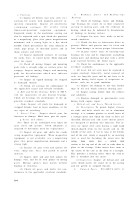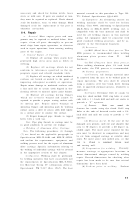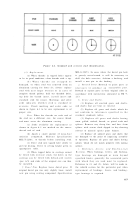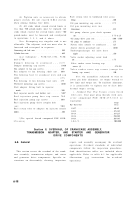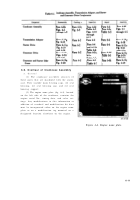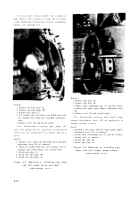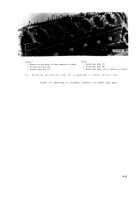TM-9-2815-200-35
ENGINE, WITH CONTAINER:TURBOSUPERCHARGED, DIESEL ,FUEL INJECTION ,90-DEGREE “V” TYPE, AIR - COOLED ,12 - CYLINDER , ASSEMBLY ;MODELS AVDS-1790-2M (2815-856-4996), AVDS-1790-2A AND AVDS-1790-2AM (2815-856-9005)
TECHNICAL MANUAL; DIRECT SUPPORT, GENERAL SUPPORT AND DEPOT MAINTENANCE MANUAL INCLUDING REPAIR PARTS AND SPECIAL TOOLS LISTS
TM-9-2815-200-35 - Page 300 of 779
castings as outlined in Specifications QQ-A-601
and
MIL-W-8604.
Preheat
slowly
in
an
oven
or
by other suitable method for two hours to ap -
proximately 350 degrees ± 35 degrees F .
Control preheat process to avoid incipien t
melting, excessive grain growth or other un -
desirable structural changes which might reduce
the mechanical properties .
Caution :
Do not attempt to preheat b y
using welding torch .
(7)
Welding .
(a)
Cracks.
The inert gas shielded ar c
welding process shall be used when makin g
repairs on aluminum alloy. After casting ha s
reached the prescribed preheat temperature ,
position the casting into the most advantageou s
welding position. Cover casting with asbesto s
blankets, except for area to be welded. Weld the
outside milled groove with a good root weld .
Apply fillet welds until groove is closed. Rotate
casting and weld inside groove in the sam e
manner if double “V” is used. Remove asbesto s
blankets and allow castings to cool progressively
to room Temperature .
(b)
Fracture and missing metal .
Following the procedure outlined in (a), above ,
place insert piece in opening, aline and secure
with clamps or tack weld in three or four places
with one inch welds. Place a good root weld in
groove and apply fillet welds until groove i s
closed. Rotate casting and weld inside groove in
the same manner .
Note.
The temperature of the castin g
surrounding the welded area should not exceed
395 degrees. If necessary, stop welding, cove r
casting with asbestos blanket and allow to cool to
a satisfactory temperature then resume welding .
(8)
Final inspection and clean up.
Repaire d
cracks and areas where metal has been replaced
must be radiographically inspected and be equa l
to or better than reference standard 3, TACO M
STD 113, Apr 69 (available from USTACO M
AMSTA-R). All other areas shall be inspecte d
by dye penetrant. Defects must be re-welded in
accordanc e
wit h
abov e
methods. Measur e
casting and compare dimensions taken befor e
repair. Dimensional change will not exceed tha t
as specified on applicable engineering drawing ,
except as noted. Check machined surfaces fo r
warpage or other dimensional changes. Clea n
seams with a wire brush and remove weld bead s
and all sharp edges. X-ray entire repaired area .
Remove excess flux with suitable material, rinse
with clean water, dry and alodize. Pressure tes t
oil passages that have been repaired to 90 ps i
hydrostatic pressure using engine oil (OE) .
d. Ball and Needle Bearings .
(1) Replace all galled, pitted, or damaged
bearings .
(2) Replace all bearings which do no t
conform to tolerances specified in the ap -
propriate repair and rebuild standards table .
(3) Refer to TM 9-214 for information o n
inspection, care, and maintenance of anti-friction
bearings .
e. Studs.
Replace all bent or loose studs o r
studs showing evidence of stretching. Repai r
minor damage with a thread chaser. Replace al l
studs having stripped or damaged threads .
Remove and replace studs as outlined in (1) and
(2), below .
(1)
Stud identification.
Stud identificatio n
tables appear in the overhaul sections of thi s
chapter. Each table contains the appropriat e
inform ation regarding stud setting heights ,
oversize studs, number required and referenc e
figures of stud identification and location .
(2)
Removal.
Using
stud
extractor,
back
studs out slowly to avoid heating and possible
seizure. When studs are broken off too short to
use stud extractor, drill stud and extract with a
suitable remover. Short studs may also b e
removed by welding a piece of bar stock or a nut
to stud and removing with a wrench .
6- 6
Back to Top









